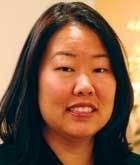An entrepreneurial model practice
by Michael Gradeless, DDS
When I conduct these interviews, a very strange thing seems to happen - the completed interview always makes it appear that success is easy. In some ways, success is easy. After only 10 years of study, sound decision-making, strategic planning, and hard work, Drs. Kwon and Jabbour have become an entrepreneurial success. While dentistry is, first and foremost, a profession, it is also a business. Rarely are dentists entrepreneurs. We commonly purchase an existing business and try to make as few changes as possible, preserve the cash flow, and make a decent living.
This is not what entrepreneurs do. The entrepreneur starts a new business based on a different vision. The entrepreneur doesn’t quit the day job until the new business is running. The entrepreneur is not simply looking to preserve cash flow. In the past, dentistry has been characterized as a profession and a business, but dentistry has rarely been the province of entrepreneurs. In this day of astronomical student loan debt, perhaps it is time for an entrepreneurial model of dentistry. I hope you enjoy the story of these extraordinary dentists.
Dr. Gradeless: You are both 1998 graduates of Temple University School of Dentistry, but then your paths diverged. Dr. Jabbour, you returned home to the San Francisco Bay area to complete your GPR at the VA hospital in Martinez, Calif., and Dr. Kwon, you completed your GPR at St. Barnabas Hospital in The Bronx. How would you characterize your GPR experiences?
Drs. Jabbour and Kwon: We felt the GPR experiences were very valuable. We were thrust into the experience of seeing 20 to 30 patients per day, which was very different from seeing two patients a day in dental school. In addition to the increased speed, an always-present attending specialist allowed us to feel comfortable trying more complex procedures. We planned on practicing in California, so attending a GPR gave us time to prepare for the California board exam while we continued to improve our clinical skills.
Once we completed our GPRs, we began working as associates in several different practices during the next two years. We worked in high-end cosmetic practices as well as high-volume managed-care practices. These experiences were not only beneficial from a clinical standpoint - where we developed our clinical skills and speed - but also we learned more about the business of running a dental practice. Collectively, this helped us define what type of practice we wanted.
Initially, we looked for a practice to purchase in the area we wanted to live. However, the practices for sale were either older practices with outdated equipment, or practices that were heavily into managed care. These were not what we envisioned, so we decided to build our practice from scratch, with each of us dedicating two full days to support the practice four days a week. We anticipated that starting a higher-end, fee-for-service practice in an established area would be a challenge; however, that was what we wanted to build. We knew it would take some time before we could both work full time in the practice, so for the first couple of years we continued to associate while our practice was growing. Once our patient pool grew enough to sustain two doctors, we were able to leave our associate positions.
Our vision was to create a pleasant and relaxing environment so patients can have a great dental experience, while we utilize the newest dental technologies. We want our patients to be completely satisfied with not only the dentistry but also the personal service they experience. It started with the architecture and overall design of the office, which creates an environment that is pleasing and relaxing - not like the traditional clinical setting. At our patients’ first visits, we take time to get to know them and educate them about their dental conditions and needs. Financial arrangements are addressed before treatment is started so there are no surprises. At treatment appointments, we make every effort to make sure patients are comfortable and satisfied with their treatment from when they first are anesthetized until after the anesthesia wears off. Our goal is to surprise our patients with how pleasant their dental experiences are. Besides enjoying the actual dentistry, we look forward to meeting new patients and seeing our existing patients from one visit to the next.
We track monthly statistics and compare them to the same month of the previous year, and likewise for quarterly statistics. Some of the numbers we look at are total monthly production and collection, average daily production, the number of new patients per month and the sources of new patients.
Employee hiring, equipment purchases, and business expansion have been phased in up to this point. As the practice continues to grow, we plan to add two more operatories, a full-time hygienist, and some more chairside and front office help.
The new-patient exam is an opportunity
We feel that the new-patient exam is our first and best chance to make a great impression, so we dedicate an hour and a half for an adult new-patient exam. Most new patients are nervous when they present for an exam, especially if they know they need treatment. A soothing and inviting office design helps them feel more comfortable. Our friendly treatment coordinator greets them and addresses any questions they may have. Patient are escorted to one of the clean, spacious, and uncluttered treatment rooms. The interview portion of the exam begins in this non-threatening environment, and patients are allowed to express any concerns. The clinical portion of the exam begins with digital radiographs, oral cancer screening, dental charting, periodontal assessment, and intraoral photographs. With these tools, we can then educate patients about their dental health and condition. They view the radiographs and photographs and become involved in the diagnosis and treatment process. Patients are invited to voice their concerns and we address them at this time.
When treatment involves an interdisciplinary approach, the patient is referred to a specialist who has the same practice philosophy. Depending on time and periodontal condition, a cleaning is performed or scheduled. The final step is financial arrangement with the treatment coordinator. Clear and convenient financial arrangements, which may include financing by CareCredit or Capital One, allows patients to proceed with treatment without the concern of financial surprises. We feel this approach has allowed us to maintain a high treatment acceptance rate.
Coming out of dental school, the aspect of private practice for which we were least prepared and trained was the business of running a practice. As we became owners of a dental practice, we had to learn how to manage and lead the practice in the direction we wanted to go. Leadership skills are learned, not innate, and every day is a learning experience.
We learned that you must not expect perfection from yourself or your staff. We are allowed to make mistakes as long as we take responsibility and learn from them. The same applies and is expected of every team member. This approach allows employees to feel empowered and have a positive attitude.
Leading by example is a major part of our daily approach. To us, that means taking pride in the quality of the service we deliver, treating patients and team members with respect, and having a positive attitude. These are very important qualities that we must set as examples for the rest of our team. If we don’t exemplify these qualities, then we cannot expect them from other team members.
If we had to give one piece of advice to other new dentists, it would be to participate in some sort of study group or a form of continuing education. By constantly learning, you can steadily improve your dental skills and your practice management and leadership skills. You will also be around other dentists who are in the same situation, and you’ll be able to learn from one another’s experiences. We have chosen to be part of the Seattle Study Club and it has allowed us to be exposed to and learn from some of the best in dentistry and practice management.
Dr. Hani Jabbour is a graduate of Santa Clara University, and a 1998 graduate of Temple University School of Dentistry. He completed a General Practice Residency (GPR) at Veterans Administration Hospital in Martinez, Calif. Upon completion, he associated in the San Francisco Bay Area for three years before starting his practice with his wife, Dr. Julie Kwon, in October 2002.
Dr. Julie Kwon is a graduate of the University of Illinois Urbana-Champaign, and received her DMD from Temple University School of Dentistry in 1998. She completed a GPR at St. Barnabas Hospital in The Bronx, N.Y., then practiced as an associate in the San Francisco Bay Area from 1999 to 2002. Dr. Kwon’s and Dr. Jabbour’s practice is located in Walnut Creek, Calif. Find out more about their practice at www.kandjdental.com or e-mail them at [email protected].
Dr. Michael Gradeless, a 1980 graduate of Indiana University, practices preventive dentistry in Indianapolis with an emphasis on cosmetics and implants. He is an adjunct faculty member at Indiana University, where he teaches the Pride Institute university curriculum of dental management. He also is the editor for the Indiana Dental Association. Contact him at (317) 841-3130 or e-mail to [email protected].


